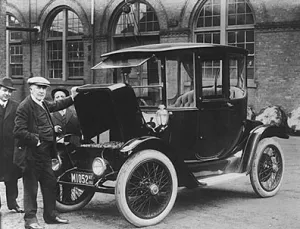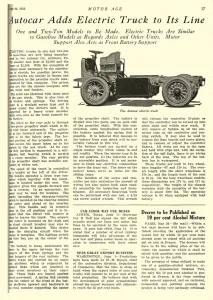The History of EVs
August 04 , 2022

Electric Cars from 1860-1930
Imagine New York City in the year 1900. In the midst of the industrial revolution, with inventors like Thomas Edison, Henry Ford, and Nicola Tesla, the United States was undergoing rapid change. But when you imagine a turn-of-the-century New Yorker entering a taxi of the time, you’re probably thinking of the famous Model T. As the first inexpensive gas-powered automobile, the Model T stands out to many Americans as the only car to grace 19th Century streets – which is a huge misconception in the history of EVs.
No, when a 1900s New Yorker opened the door to their taxi, there was a good chance it was an electric vehicle. In fact, electric vehicles were widely popular in the United States, as combustion engines of the era were too noisy and required a difficult hand crank startup. Though just a few decades, electric vehicles were fairly pervasive until Model T, which was cheaper and didn’t require a hand crank, changed the tides. In both our collective memories and in the marketplace, the Model T pushed electric vehicles into obscurity.
So let’s have a look at the true history of EVs in the United States.
The Early History of EVs
The history of electric vehicles actually starts with the electric motor. This remarkable invention is widely credited to Thomas Davenport, an American blacksmith. By harnessing the power of magnets through an electric pile (an early battery developed by Alessandro Volta), Davenport created what is known as a “brush and commutator.” This device functions to reverse magnet polarity, which in the case of his motor, created a rotor that could spin continuously as long as electricity was applied. That was in 1834 – Davenport would spend many years convincing others his motor could be the foundation of electric trains. Although others had created ways of transforming electricity into mechanical energy, Thomas Davenport’s electric motor, when deployed in a toy car on a track, would serve as the model for electric streetcars.
Davenport initially struggled against institutional sluggishness when he tried to spread the word about the electric motor. Humorously, the patent he filed was rejected on the grounds that an electric device had never been patented in America before. In order for the motor to really take off, it would require an entrepreneur with a knack for innovative applications. It would find such a person in Thomas Parker, an inventor and businessman in England in the late 19th Century. By the time Parker invented the first electric car, he had already been electrifying England for years. His dynamos and electric lights kept coal mines lit, and he helped to electrify trams and the London Underground. With Parker’s talent and vision, the electric car had been born – and though he’d drive to work in his creation, he’d regularly complain that the hilly topography drained his batteries too quickly. Clearly, EVs still had a little way to go before they could be practically adopted.
The History of EVs in America

According to the US Department of Energy, however, it wouldn’t be too long before the first successful electric car would strike a chord in the United States. In 1890, William Morrison created a six-passenger car that would be the founding technology for a coming trend. At the time, Morrison’s electric car could hit 14 miles an hour – two full miles above the speed limit for motor vehicles in New York City.
The extra speed Americans were getting from that electric motor wasn’t put to waste, either. Within a decade the first speeding ticket in America would be given to an electric vehicle. By then, you could find those electric taxis all throughout New York, Paris, and Mexico City, and electric motors started finding their way into commercial businesses. In 1899, the Autocar company released its first electric truck. In 1907, London had an electric bus service courtesy of the London Electrobus Company – you could even find electric busses in West Point, ferrying students to and fro.
The Decline of the Electric Motor

Unfortunately for EVs, it was also around this time that Henry Ford created the Model T. A gasoline-fueled automobile, the Model T’s ease of use and affordability effectively ended the commercial desirability of electric cars. Selling at less than half the price of an electric model, many more people could afford a Model T. In the same year the Model T released, the electric starter was created. Using a battery, gas engines could now start nearly instantly, as compared with the long warm-up time of the physically demanding crank-start method. By removing the accessibility barriers for gasoline engines, these inventors have paved the way for gas-powered cars to dominate the 20th Century, and even the start of the 21st. They’d also indirectly killed the electric vehicle.
Although you could see electric vehicles on the market for years after, it wouldn’t be until the 70’s that electric cars would get a jump start.
1960 – 2000
Achilles’ Heel: Gas-Power Becomes Problematic
By the 1960s, electric vehicles had almost completely left the public consciousness. Gas cars were the standard, and Americans had been finding ways to make them faster, more powerful, and more attractive every decade. At this point, unseating the internal combustion engine as transportation king would take a major economic event. Cue the Oil Embargo of 1973.
Throughout the ’60s, oil and gas prices had been on the rise. Suddenly, automobile ownership was coming with costs that had never been imagined previously. By the time the oil embargo came, the United States was already looking for ways to decrease its dependence on foreign oil. As long lines formed at gas stations around the country, the government was already repositioning itself. In 1976, Congress passed the Electric and Hybrid Vehicle Research, Development, and Demonstration Act. With new authority to support the research and development of electric vehicles, the Energy Department would begin paving the way for modern electrification technology.
Electric Vehicles Re-imagined
Of course, by the time Congress passed that act in 1976, the country had already seen perhaps the most incredible use-case for electric vehicles: Space exploration. In 1971, Americans were treated to amazing glimpses of the Lunar Roving Vehicle – aka the Moon rover – an all-electric vehicle purpose built to drive in the Moon’s low-gravity vacuum. This was a big moment in the history of EVs. As the world turned its eyes to the stars, they needed new technologies to break through into these new frontiers. With no easy way to refuel gas without adding weight, electricity became the clear choice when building vehicles designed to traverse extraterrestrial terrain.
This historic application of electric vehicles, alongside the crushing weight of increased fuel prices, made it fairly easy for Congress to consider alternatives to internal combustion engines. General Motors had even produced a prototype electric car that it showed off at the EPA’s Symposium on Low Pollution Power Systems Development. It was also around this time that legendary automotive magazine Car and Driver published their first-ever review of an electric vehicle – the Pioneer. By 1975, the United States Postal service was testing a pilot program using electric jeeps from the American Motor Company. With their expertise in automobiles, it was natural that car manufacturers would take up the challenge.
It was the development of all-new technology, however, that was required to move from EV history to EV future. Manufacturers could iterate on electric vehicles forever, but without something new, the same drawbacks remained: low ranges (40 miles), low speeds (45 miles per hour), and a lack of pervasive fueling options. In 1980, Oxford University’s John Goodenough and his research team created the cobalt-oxide cathode. A cathode, as opposed to an anode, is the component in a battery that allows electricity to flow both internally and externally. The cobalt-oxide cathode became central to the development of the lithium-ion battery, and many modern automobile batteries would come to function with a layered version of this technology. The cobalt-oxide cathode was so revolutionary that Goodenough and colleagues received a Nobel Prize for their contributions.
The Environmental Rennaissance in History of EVs
After the environmental movements of the 60’s and 70’s, America had become firmly rooted in an environmentally-oriented perspective. Within the passage of the Clean Air Act and Energy Policy Act, Congress was setting a clear goal: Reduce our emissions and improve our resource consumption. Although in the 70’s the nation was poised to explore new electrification technology, now Congress was regulating the petroleum-based industries that had been growing for almost a century. This was a major shift in thinking, but the California Air Resources Board (CARB) would soon take it one step further.
EV History Meets New Regulations
Have you heard of the ZEV Mandate? It’s one of the most influential and consequential pieces of legislation in the history of EVs. In 1990, CARB set out to ensure that polluting automobile manufacturers would build zero-emission vehicles (ZEV). This is the heart of the ZEV Mandate, which required that automobile manufacturers ensured that 2% of their vehicles produced for sale would be ZEVs. Even though it was just one state, California was setting an example that the nation would eventually follow – namely, forcing the markets to adopt this new technology. Combined with constantly improving electrification technology, the age of the EV was beginning once again.
Previously, manufacturers were incentivized to explore new technology. In fact, even during this period in the late 20th Century, the Energy Department was still sponsoring improved electrification and battery technology. However, the ’90s favorable economic situation in the United States meant that everyone – from auto manufacturers to consumers themselves – was a little slow in recognizing the value of electric vehicles. Now, with environmental priorities at the forefront of the national agenda, ICE production and carbon emissions were being disincentivized. It was during this period in the late nineties to the early 2000’s that many of the first American EVs were launched.
The most famous of these might be the EV1 from GM. Featured in the film “Who Killed the Electric Car?” the EV1 was an ambitious vehicle that finally brought electric vehicles up to speed, literally. Able to hit 50 miles per hour in seven seconds and drive for 80 miles, the EV1 was as exciting as it was expensive. Never available for sale, the lease-only EV1 was discontinued in 2001. It wasn’t until the Honda Insight in 1999 that an electric vehicle would actually be sold in the United States. It was the first vehicle in EV history sold since the first half of the 1900s.
By the dawn of the new millennium, gas had been shown to be a geopolitically unreliable resource and the concepts of climate change and global warming had been introduced to the public at large. With the popular Toyota Prius Hybrid Electric Vehicle (HEV) showing glimpses of how an EV market could take off, more and more commercial support was building for electrification efforts. With new technologies supported by the Department of Energy and regulations that were bringing out-of-date manufacturers into the future, America was poised to take the electric vehicle market by storm – without even a single mention of the word “Tesla.”
But our newly forward-thinking attitude was a little late. In Part 3 of the History of EVs, we’ll learn why although the modern world’s biggest EV celebrity is American, another major country has made itself into the dominant force in the EV global marketplace.




